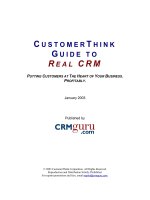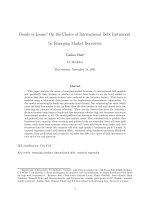The organization of international business
Bạn đang xem bản rút gọn của tài liệu. Xem và tải ngay bản đầy đủ của tài liệu tại đây (530.21 KB, 53 trang )
International
Business 7e
by Charles W.L. Hill
McGraw-Hill/Irwin Copyright © 2009 by The McGraw-Hill Companies,
Inc. All rights reserved.
Chapter 13
The Organization of
International Business
13-3
Introduction
Organizational architecture refers to the totality of a firm’s
organization, including formal organization structure, control systems
and incentives, processes, organizational culture, and people
To be the most profitable, firms need to be sure:
the different elements of the organizational architecture are
internally consistent
the organizational architecture matches or fits the strategy of the
firm
the strategy and architecture of the firm are consistent with each
other, and consistent with competitive conditions
13-4
Organizational Architecture
Organizational structure refers to:
the formal division of the organization into subunits
the location of decision-making responsibilities within that structure
(centralized versus decentralized)
the establishment of integrating mechanisms to coordinate the
activities of subunits including cross-functional teams or pan-regional
committees
Control systems are the metrics used to measure performance of
subunits and make judgments about how well managers are running
those subunits
13-5
Organizational Architecture
Incentives are the devices used to reward appropriate managerial
behavior
Processes are the manner in which decisions are made and work is
performed within the organization
Organizational culture refers to the norms and value systems that are
shared among the employees of an organization
People refers to not just the employees of the organization, but also
the strategy used to recruit, compensate, and retain those individuals
and the type of people they are in terms of their skills, values, and
orientation
13-6
Organizational Architecture
Figure 13.1: Organizational Architecture
13-7
Classroom Performance System
The norms and value systems that are shared among the employees
of an organization are called
a) processes
b) organizational culture
c) control systems
d) incentives
13-8
Organizational Structure
Organizational structure has three dimensions:
1. Vertical differentiation - the location of decision-making
responsibilities within a structure
2. Horizontal differentiation - the formal division of the
organization into sub-units
3. The establishment of integrating mechanisms - the
mechanisms for coordinating sub-units
13-9
Vertical Differentiation:
Centralization And Decentralization
Vertical differentiation determines where decision-making power is
concentrated
Centralized decision-making:
facilitates coordination
ensure decisions consistent with organization’s objectives
gives top-level managers the means to bring about
organizational change
avoids duplication of activities
13-10
Vertical Differentiation:
Centralization And Decentralization
Decentralized decision-making:
relieves the burden of centralized decision-making
has been shown to motivate individuals
permits greater flexibility
can result in better decisions
can increase control
It can be worthwhile to centralize some decisions and decentralize
others
13-11
Classroom Performance System
Which of the following is not an advantage of centralized decision-
making?
a) It facilitates coordination
b) It motivates employees
c) It gives top-level managers the means to bring about organizational
change
d) It avoids duplication of activities
13-12
Horizontal Differentiation:
The Design Of Structure
Horizontal differentiation is concerned with how the firm decides to
divide itself into sub-units
The decision is usually based on:
function
type of business
geographical area
13-13
Horizontal Differentiation:
The Design Of Structure
Most firms begin with no formal structure
As they grow, the organization is split into functions reflecting the
firm’s value creation activities (functional structure)
The functions are typically coordinated and controlled by top
management
Decision-making tends to be centralized
If the firm diversifies its product line, further horizontal differentiation
may be necessary
Firms may switch to a product divisional structure where each
division is responsible for a distinct product line
13-14
Horizontal Differentiation:
The Design Of Structure
Figure 13.2: A Typical Functional Structure
13-15
Horizontal Differentiation:
The Design Of Structure
Figure 13.3: A Typical Product Divisional Structure
13-16
Horizontal Differentiation:
The Design Of Structure
When firms expand internationally, they often group all of their
international activities into an international division
In time it might prove viable to manufacture the product in each
country
The result could be that firms with a functional structure at home
would replicate the functional structure in every country in which they
do business and firms with a divisional structure would replicate the
divisional structure in every country in which they do business
The creates the potential for conflict and coordination problems
between domestic and foreign operations
13-17
Horizontal Differentiation:
The Design Of Structure
Figure 13.4: One Company’s International Divisional Structure
13-18
Horizontal Differentiation:
The Design Of Structure
Many firms that continue to expand will abandon their international
division structure and move to either a:
Worldwide product divisional structure - tends to be adopted by
diversified firms that have domestic product division
Worldwide area structure - tends to be adopted by undiversified
firms whose domestic structures are based on functions
13-19
Horizontal Differentiation:
The Design Of Structure
Figure 13.5: The International Structural Stages Model
13-20
Horizontal Differentiation:
The Design Of Structure
The worldwide area structure:
is favored by firms with low degree of diversification and a domestic
structure based on function
divides the world into autonomous geographic areas
decentralizes operational authority
facilitates local responsiveness
can result in a fragmentation of the organization
is consistent with a localization strategy
13-21
Horizontal Differentiation:
The Design Of Structure
The worldwide product division structure:
is adopted by firms that are reasonably diversified
allows for worldwide coordination of value creation activities of each
product division
helps realize location and experience curve economies
facilitates the transfer of core competencies
does not allow for local responsiveness
13-22
Horizontal Differentiation:
The Design Of Structure
Figure 13.6: A Worldwide Product Divisional Structure
13-23
Horizontal Differentiation:
The Design Of Structure
The global matrix structure is an attempt to minimize the limitations of
the worldwide area structure and the worldwide product divisional
structure
The global matrix structure:
allows for differentiation along two dimensions - product division and
geographic area
has dual decision–making - product division and geographic area
have equal responsibility for operating decisions
can be bureaucratic and slow
can result in conflict between areas and product divisions
can result in finger-pointing between divisions when something goes
wrong
13-24
Horizontal Differentiation:
The Design Of Structure
Figure 13.7: A Global Matrix Structure
13-25
Classroom Performance System
Most firms begin their international expansion with a(n) ________
structure.
a) Matrix
b) Worldwide product division
c) Worldwide area division
d) International division









